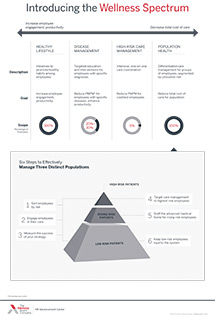Auto logout in seconds.
Continue LogoutEditor's note: This popular story from the Daily Briefing's archives was republished on Oct. 17, 2019.
A short break from exercising could have long-term health consequences, and the chances of negative effects increase with age, according to two new studies, Gretchen Reynolds writes for the New York Times.
Understand the wellness spectrum—and promote healthy habits at work
The effects on 'healthy' adults
For one of the new studies, researchers at the University of Liverpool in England instructed 45 "active" and "metabolically healthy" adult men and women to walk fewer than 2,000 steps daily and to sit for at least three and a half hours longer each day. Prior to the study, participants walked more than 10,000 steps per day.
After two weeks of decreased physical activity, researchers recorded changes in participants' metabolisms and body compositions. Participants returned to their former activity levels for another two weeks before the tests were repeated.
The study results were "consistent if worrisome," Reynolds writes. The majority of the study participants experienced increased blood sugar levels, decreased insulin sensitivity, and unhealthy cholesterol profiles. The testing also found an increase in fat around participants' abdomens and decreased muscle mass in their legs.
The majority of participants reversed these "metabolic derangements" after returning to their active lifestyles. But some had "pervasive and persistent" symptoms of insulin resistance and were less physically active in the weeks following the study, Reynolds writes.
Effects among elderly adults
A second study honed in on an older demographic—those ages 65 and older—and the results indicated that the consequences of inactivity are more severe, and potentially longer lasting, the Reynolds reports.
Prior to the study, most of the participants were prediabetic, but maintained a healthy activity level and walked between 7,000 and 8,000 steps each day.
For the study, participants were instructed to reduce their daily step-count to 1,000 or fewer for one week. Participants were able to resume their previous levels of activity over the following two weeks.
After the first week, researchers observed increases in insulin resistance and blood sugar, as well as signs of decreased muscle mass among participants. A few participants were removed from the study after they developed Type 2 diabetes. Participants in this study, however, were less likely to see the metabolic changes completely reverse after two weeks of increased activity, particularly among older, overweight adults.
To prevent health consequences, 'don't stop moving'
Chris McGlory, a research fellow in kinesiology at McMaster University in Canada, said the findings suggest the negative health effects of short-term inactivity—such as a week-long vacation or rest due to injury—could have long-term metabolic consequences that may increase with age.
Reynolds noted that previous research has suggested that the consequences of inactivity are fleeting and reverse shortly after activity levels are restored. However, those studies largely focused on young college-age adults.
"It's not uncommon for older people to become sick or injured and wind up hospitalized or housebound for several weeks, or for someone who's younger to just decide to take a few weeks off [from exercise]," McGlory said. He recommended that people integrate exercise into every vacation and, in the case of injury or illness, consult a physical therapist to discuss exercise options.
But, "if it's at all possible, don't stop moving," McGlory said (Reynolds, New York Times, 8/1).
Understand the wellness spectrum—and promote healthy habits at work
Programs aimed at promoting healthy habits among employees are likely to lead to improved employee engagement and productivity—but they're unlikely to reduce the total cost of care. To do that, you'll need to take a population health approach.
Don't miss out on the latest Advisory Board insights
Create your free account to access 1 resource, including the latest research and webinars.
Want access without creating an account?
You have 1 free members-only resource remaining this month.
1 free members-only resources remaining
1 free members-only resources remaining
You've reached your limit of free insights
Become a member to access all of Advisory Board's resources, events, and experts
Never miss out on the latest innovative health care content tailored to you.
Benefits include:
You've reached your limit of free insights
Become a member to access all of Advisory Board's resources, events, and experts
Never miss out on the latest innovative health care content tailored to you.
Benefits include:
This content is available through your Curated Research partnership with Advisory Board. Click on ‘view this resource’ to read the full piece
Email ask@advisory.com to learn more
Click on ‘Become a Member’ to learn about the benefits of a Full-Access partnership with Advisory Board
Never miss out on the latest innovative health care content tailored to you.
Benefits Include:
This is for members only. Learn more.
Click on ‘Become a Member’ to learn about the benefits of a Full-Access partnership with Advisory Board
Never miss out on the latest innovative health care content tailored to you.

